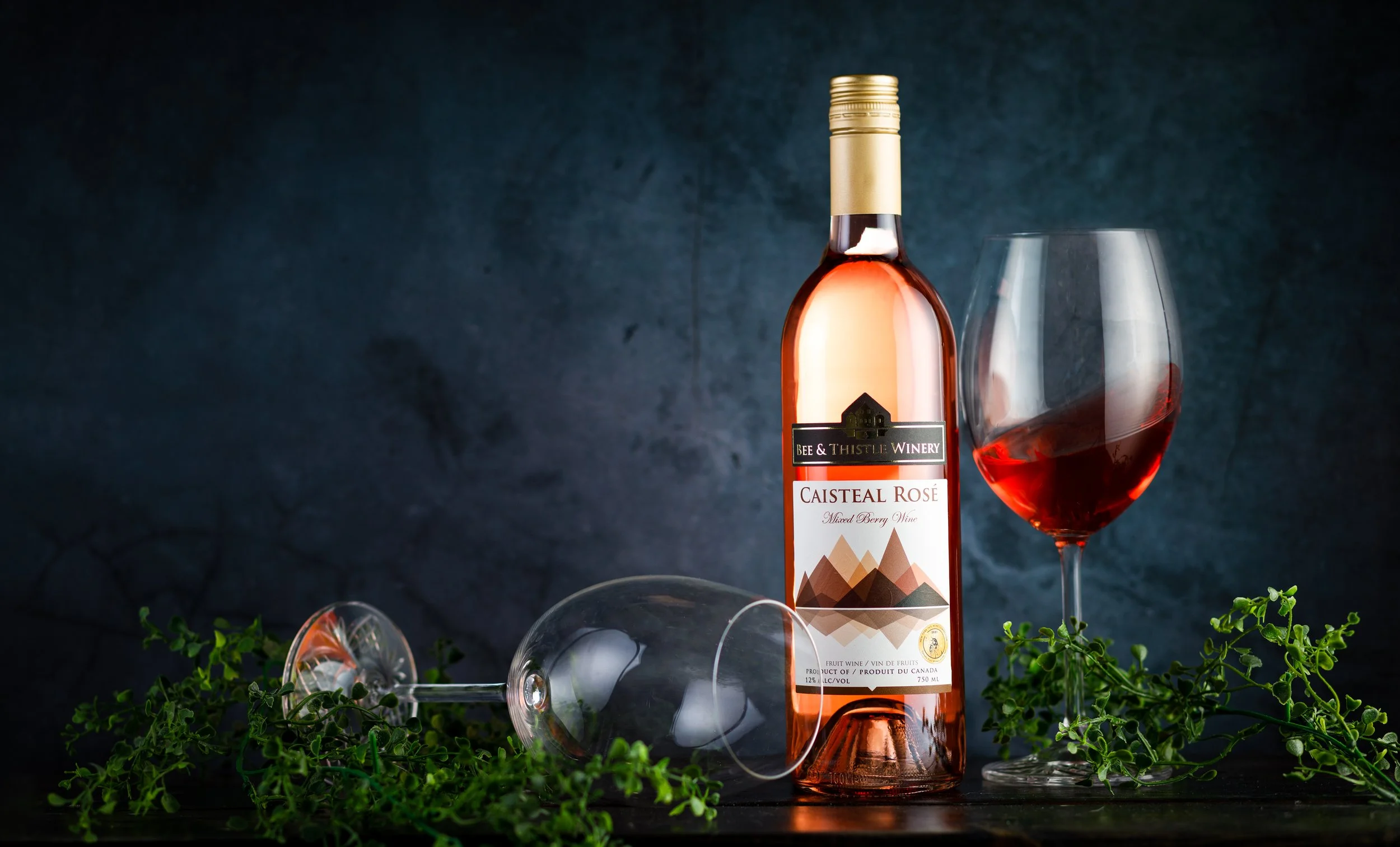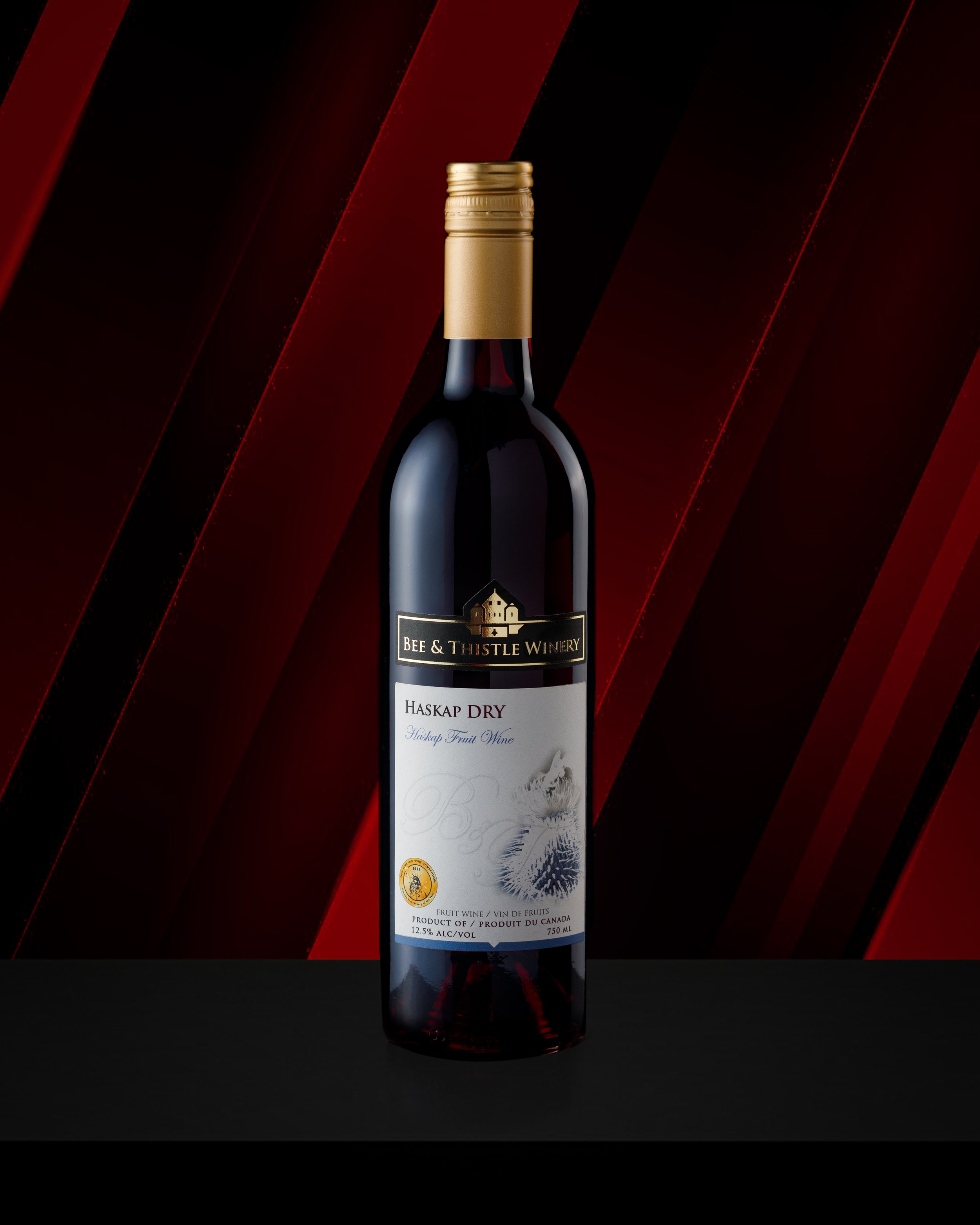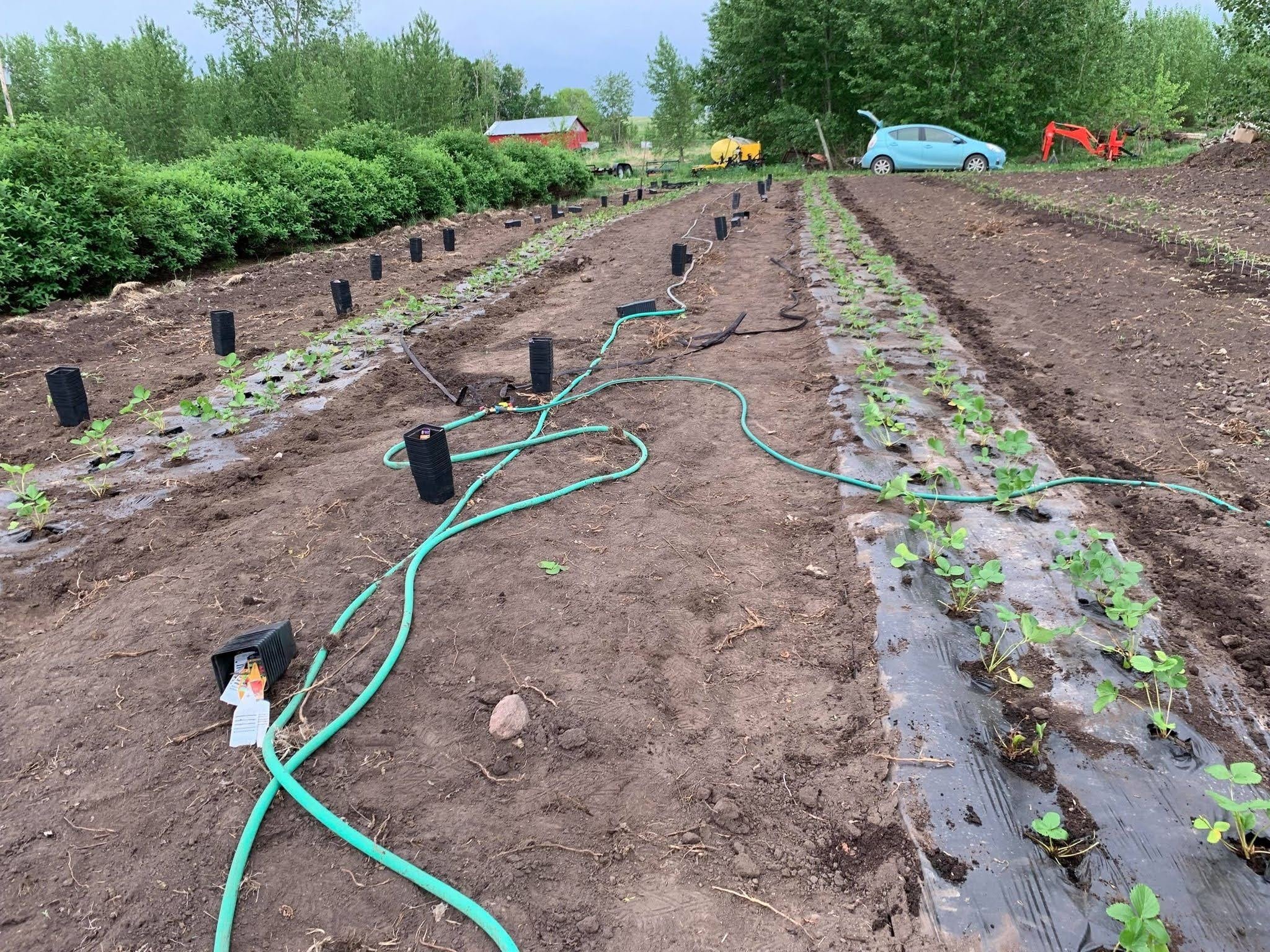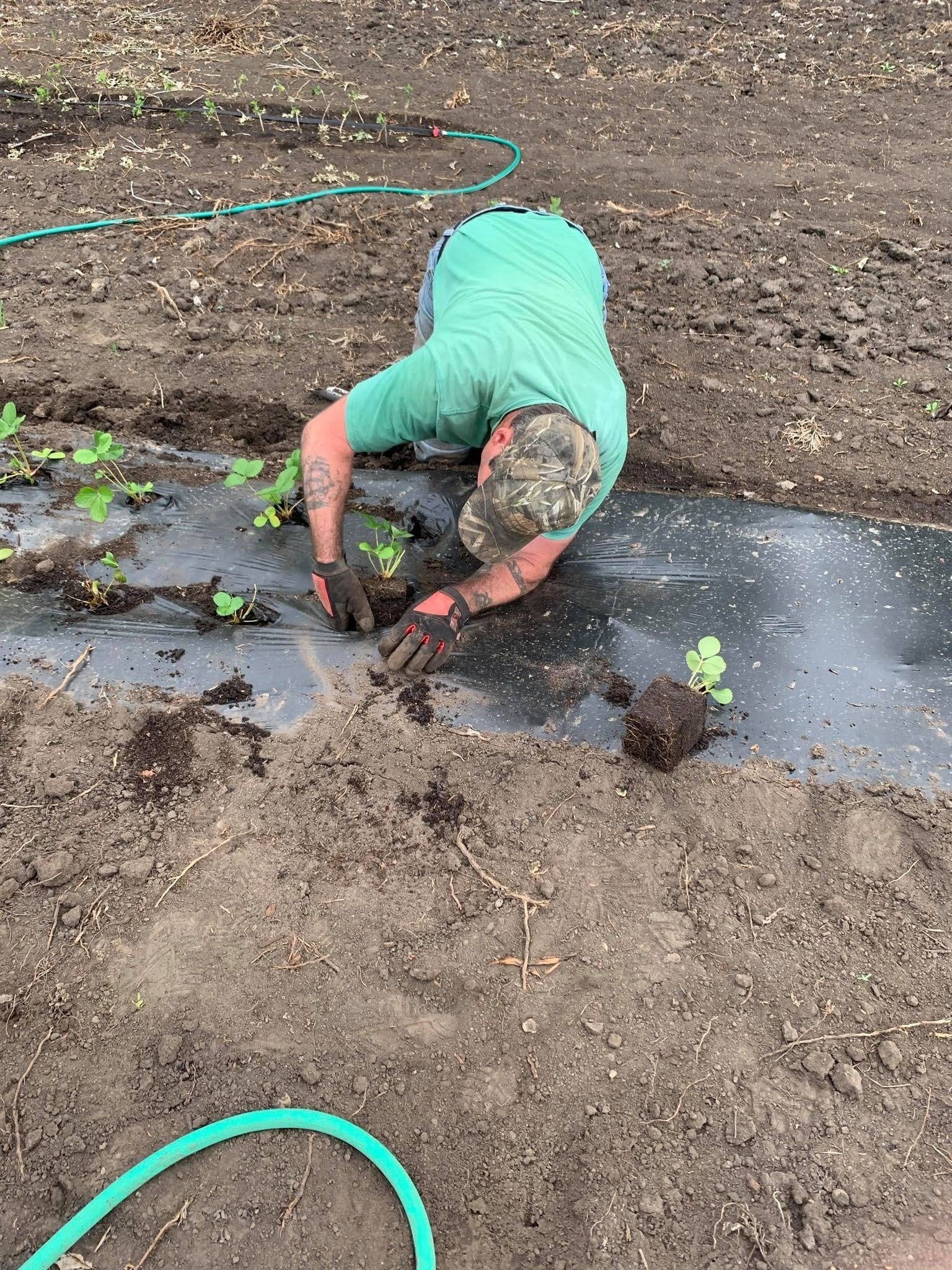Bee & Thistle Winery Fruit
Bee & Thistle Orchard Haskap
Chiad Fhion Haskap Fruit Wine
TASTING NOTES
Chiad Fhion Haskap Fruit Wine (Chiad Fhion means first wine in Gaelic) expresses unique Haskap intensity in an aged wine; the complexity of aroma and flavours meld cherry-forward, with raspberry and black currant. Aromatically distinctive, our Chiad Fhion has a bright fruity finish, complemented by a hint of oak. Each batch is proving to be an improvement to the previous batch; our first competition entries garnered a gold, 3 silvers and a bronze!
Bee & Thistle Haskap Orchard
Bee & Thistle’s initial Haskap plantings consisted of Indigo Gem, Tundra and their pollenizer, Berry Blue. In subsequent years, we’ve added Smart Berry Blue and Aurora to the lineup. All these varieties, except the Berry Blue, were developed by Dr. Bob Bors (in conjunction with Dr. Rick Sawatsky) of the U. of SK Plant Breeding program, and we paid royalties to the University for each plant thus sold. We intend to expand our plantings in the next few years with some of the newer varieties as they are developed. Certainly, in a few short years, we have seen how productive Aurora can be and how it compares favourably with our current program of Indigo Gem and Tundra, both acting as pollenizers and very good producers, with larger, sweeter berries and hardier plants. Newer orchard developers are tending toward the Blizzard and Boreal, Beauty and Beast varieties, which bloom a bit later and are a bit bigger and sweeter. If we refurbish our orchard, we may well consider newer varieties.
Because of the University’s Fruit Program success, Haskap is now grown in Canada and the United States (although the USA has its own program, they are now coordinating extensively with U. of SK). Haskap has been propagated in many eastern Europe countries (particularly Poland and Czechoslovakia), in addition to the originating countries of Japan and Russia. Haskap has been found growing wild in just about every province in Canada, but not as an edible species.
Interesting facts of the Haskap include:
the berries grow on bushes that form a globe shape and can grow five to seven feet tall over five to seven years;
the fruit is an oblong, dusty indigo coloured berry about one centimetre diameter and between one and four centimetres long;
they are one of the first fruit crops to set and ripen in the Canadian growing season; harvesting occurs in late June and into early July; and
all varieties of Haskap need a pollenizer, which is just another variety not closely genetically related;
the flowers (also produced in pairs) come out just before the leaves do, and the plants fruit on second-year wood. After flowering, and while the Haskap are developing, new shoots of wood will grow from the existing ones producing fruit the following year.
Haskap can be used in spirits (particularly gin) and liqueurs, juice, jam, chutneys, ice cream, yogurt, dried berries, and powdered berry mixes. Haskap also taste very good on cereal, by themselves for fresh eating, and when used as a sauce on meats, particularly venison and pork. Haskap nutraceuticals are also being developed and producers are manufacturing Haskap in powder and even capsule form for health.
So, what else can one do with the Haskap? Winemaking is our choice! Once you taste it, you’ll know why. The Haskap is high in phenolics which includes colour and tannins and high in natural sugar, with mainly citric and malic acids giving it a good profile for winemaking. The sensory properties of Haskap will be developed to their potential as the wine is professionally fermented and produced in small batches to retain its unique character profile.
All the Haskap used in the winery are machine harvested and hand sorted, and stored in commercial freezers until used.
We also have developed a Haskap DRY, sister to Chiad Fhion without the sweetness, at less than 10 g/L of sugar (this works out to ¼ tsp per glass).
Haskap Wine is also used in the Winery for making Haskap Eau-de-Vie, the distillate of Haskap Wine. This is crafted at Great Gido’s Distillery in Alvena, SK, and used to fortify our signature wine, Chiad Fhion, and creates a pleasing and sweet The Abbey Fortified Haskap Dessert Wine. It is also used to fortify our signature Black Currant Wine to make Kinlochaline Fortified Black Currant Dessert Wine.
Bee & Thistle Orchard Rhubarb
Loch Aline Rhubarb with Haskap Fruit Wine
TASTING NOTES
Loch Aline Rhubarb with Haskap Fruit Wine features distinctive German Wine Rhubarb first, enhanced by the complexity of tropical mango and pineapple. With a crisp citrus finish, accented by a hint of Haskap aroma, our semi-sweet Loch Aline is smooth and delicious. Each vintage varies slightly from the previous.
Loch Aline 2021 highlighted tropical fruit notes first as compared to Loch Aline 2020, accenting the natural flavours of German Wine Rhubarb, with a hint of Haskap, complemented by a lingering citrusy finish. Gentle citrus aromatics enhance the brightness of this semi-sweet crisp wine. Loch Aline 2022 was a slightly crisper with more tropical flavour and aroma, and a hint of cooking spice (not added, but developed by the fruit).
In addition, we have a Rhubarb DRY, also with a touch of Haskap and, with less than 10 g/L of sugar, a healthy alternative to regular Loch Aline. German Wine Rhubarb is also used to make Caisteal Rosè, our mixed berry wine.
Rheum x hybridum
Although technically a vegetable, we are using it as a fruit.
Our German Wine Rhubarb was purchased from a grower in Nova Scotia as divided rhizomes. It is like Victoria Rhubarb but is slightly more vigorous and intense in colour and has a darker pink speckling on a green stem. The German Wine Rhubarb stalks are large, dark red, very sweet, yet quite low in acidity. Each year, we plan to divide as appropriate with an ultimate production goal of 4000 L of German Wine Rhubarb Wine. We currently have about 500 German Wine plants. Bee & Thistle Orchards sold several dozen roots in 2020-22, including a major fruit and vegetable farm in Quebec. Please use the contact us form if you wish to be put on the list for next year’s divisions (we divide in late Fall and truck ship only in Canada—the window for dividing and shipping is very short—about a week due to our extremely early winter).
Because of its high sugar content, intense colour and unique flavour profile, Bee & Thistle Winery chose the German Wine variety for its Rhubarb wine. Our Winemaker will carefully monitor and make the necessary adjustments to ensure a top-quality product from the available fruit each year.
Ravensfield Orchard Black Currant
Angus Ban Limited Reserve Black Currant, Kinlochaline Fortified Dessert Fruit Wine and MacAngus Select Black Currant
Ribes nigrum
Ravensfield Farm supplies the Bee & Thistle Winery with Black Currants to expand the fruit wine flavour selections available to you. It has selected the Ben Nevis variety for its Black Currant Wine, aptly name Angus Ban. Until the plants are productive enough to make a full batch, we have purchased from Popham Lane Farm in Ontario, believing their Whistler fruit to be of the quality and flavour we needed to produce our 2020 vintage, MacAngus.
The initial planting was 100 2-year-old Ben Nevis shrubs, added to the orchard in late May 2019. Over the next 2 years, cuttings were taken from healthy plants and the Black Currant section of the orchard will expand to 5 rows of 88-100 plants each (470 plants) and one row of 40 plants at the end of the Saskatoon row. The goal is to have at least 500 actively producing plants. We hand harvested our first planting in 2020, harvested by machine and sorted by hand in 2021, and mostly mechanically harvested although hand selected in 2022.
The Ben Nevis variety of Black Currants was chosen for its hardiness, fruitfulness, freedom from disease and ease of care. It grows approximately 4 feet high and 3 feet wide, filling out to ground level. Because it is a full shrub, it must be pruned.
Black Currant pruning takes place in late summer following harvest. They need to be judiciously pruned for several key reasons:
proper pruning will maximize fruit production the following year
the growth area will be free of disease
plants will become stronger; and
plants will be healthier overall
Black Currant fruit is borne primarily on one-year-old shoots. Our newly planted bushes will be pruned quite severely, cutting all shoots back to two buds above ground level. The general rule is to remove all weak shoots and those growing out sideways (this encourages an upright habit which facilitates mechanical harvesting). The remaining branches will be thinned to remove old, unproductive wood and to encourage new shoots. An established bush will not be allowed to become overcrowded and will have about one third of its main branches or stems removed each year.
We look forward to seeing how well our Black Currants do in remote Saskatchewan. All signs point to a promising growth period followed by successful harvesting each year.
Bee & Thistle Orchard Strawberry
Fragaria sp. ‘Day Neutral’; Fragaria sp. ‘Everbearing’
Bee & Thistle Orchards established 300 Strawberry plants in 2021. Planted in plastic mulch, and irrigated as required, these plants and varieties were chosen because they produce all summer long into the fall.
Most of the early flowers were taken off so the plants could root successfully, with a small quantity of fruit harvested for home use the first year.
The runners are cut in late summer, rooted, and re-established in new sections of the bed, so the whole bed will be renovated each year, with the ‘mother’ plant destroyed and mulched every 3 years. Since these plants are such aggressive feeders, compost and natural fertilizers (mostly well-rotted/composted and sustainably sourced local cow manure), is worked into the soil well before planting. We also added some natural blue stone and sulfur to the soil for fungus control. Again, working on sustainable practices in all our orchards.
All Strawberries are hand harvested and hulled, then washed carefully before sorting into Ziplock™ bags and then sanitized buckets of 20 lbs each.
The frozen fruit pails are stored at Fresh Pack commercial freezers in Saskatoon until thawed. We currently use them in two of our wine products: Caisteal Rosé and Linnhe Strawberry Fruit Wine.
Our Caisteal Rosé has mixed fruit, with Strawberries comprising about 15% of that mix, depending on availability. Future plans include testing a small batch of Strawberry-Rhubarb wine.
Ravensfield Orchard Saskatoon Berry
Amelanchier alnifolia 'Northline'
In addition to the name Saskatoon, these berries are also known as prairie berries, serviceberries, shadbush and June berries. There are many varieties available throughout its native lands of North America. Ravensfield has chosen the Northline variety of the Saskatoon berry for planting in its orchard. This variety will produce excellent berries for winemaking.
The Northline is a large self-pollinating shrub that grows to approximately 10 feet tall and 7 feet wide. The shrubs are covered in small white flowers in spring before leaves comes out. Small, sweet blue coloured round berries are ready for picking in early June beginning three years after planting.
Unlike other fruit types, the Saskatoon berry is not particular as to soil type or pH; however, a program of tissue testing, and soil amendments has been initiated to optimize berry quality. It prefers moist ground, so we need to ensure the plants stay properly irrigated. The orchard is open to full sun so these sun-loving plants should thrive there. The orchard is fully fenced in to keep deer from enjoying the fruit, but we still need to watch for other pests, including rabbits, mice, and grasshoppers. Non-chemical methods will continue to be used for pest deterrence.
Collin and the team planted his first Saskatoon shrubs in 2018 in the Bee & Thistle Orchard nursery (first picture on the left). Then in 2019, they were transplanted to Ravensfield, their permanent home (middle picture). The last picture was taken in May 2020, showing they continue to do well. We expect them to grow significantly this year. To augment this selection, Collin planted more in early June.


















